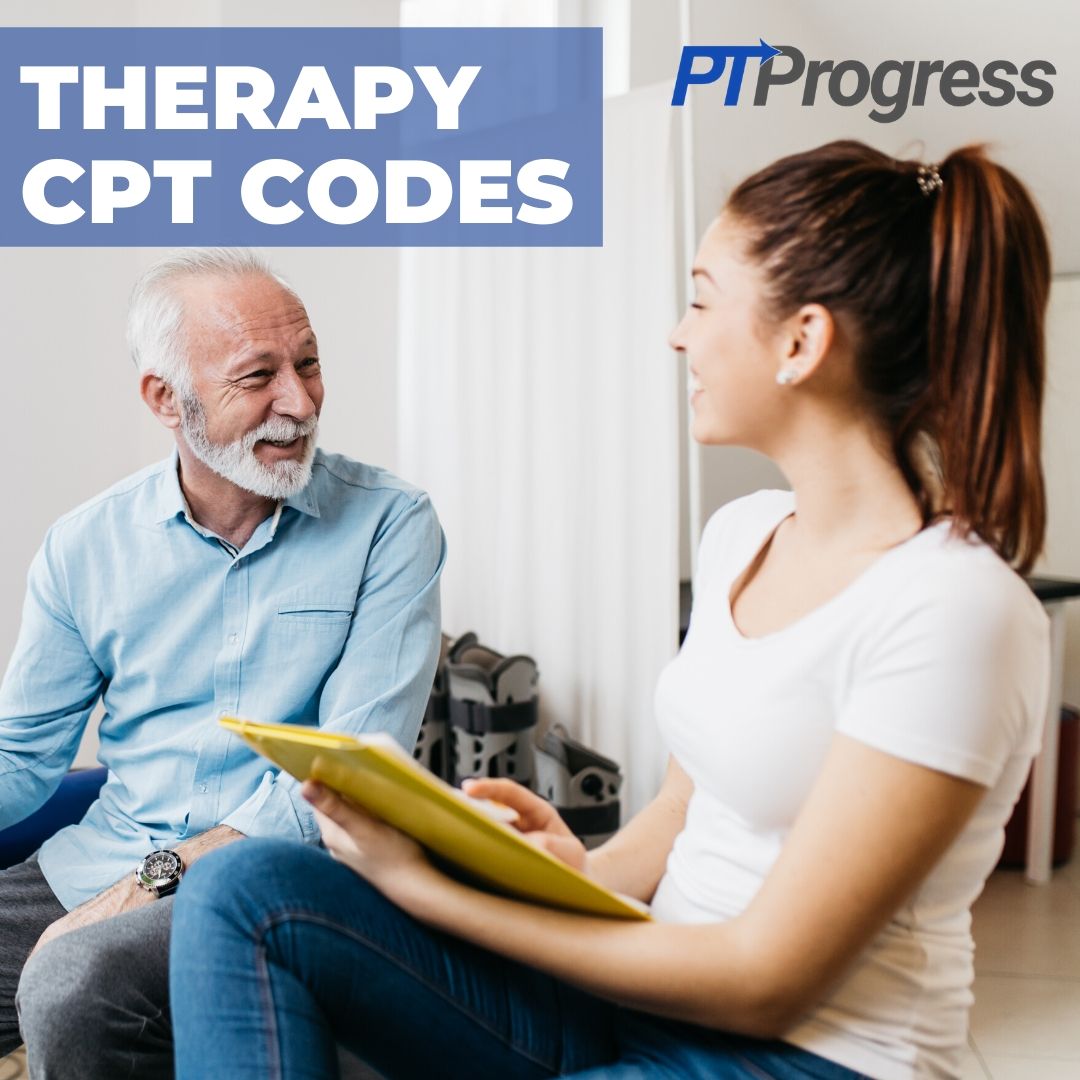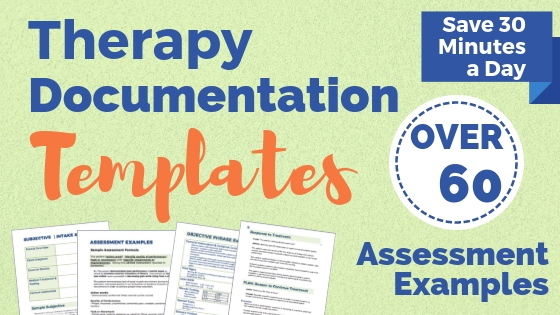 A Quick Review of CPT Codes and ICD-10 Codes
A Quick Review of CPT Codes and ICD-10 Codes
CPT stands for Current Procedural Terminology and are published by the American Medical Association. Ranging from 00100 to 99499, the CPT codes are used to describe medical, surgical, and diagnostic services and procedures.
Medical professionals like Physical Therapists use CPT codes to classify the treatment of diagnoses. ICD-9 Codes (International Classification of Diseases 9th edition) are used to classify signs, symptoms, injuries, diseases, and conditions.
The idea is that the CPT code (treatment, service, procedure) matches up logically with the ICD-10 code (the symptom, injury, etc.). If the CPT code doesn’t support the ICD-10 code, you’ll have a problem – and you’ll likely have trouble getting reimbursed.
Improve Your Clinic’s Productivity with Documentation Templates
The average therapist spends 1 to 2 hours a day writing notes for documentation. Save time with these well crafted, skill reflective, treatment specific documentation templates. Click below to learn more about our therapy documentation templates.
Common Physical Therapy CPT Codes
The most commonly used CPT codes for Physical Therapy are listed below. For example, the CPT code for therapeutic exercise is 97110. The CPT code is listed on the left, the name of the code is in the middle and the description is in the right column.
|
97161 97162 97163 |
Physical Therapy Evaluation CPT
Low complexity Moderate complexity High complexity |
|
|
97165 97166 97167 |
Occupational Therapy Evaluation CPT
Low complexity Moderate complexity High complexity |
|
| 97164 | Physical Therapy Re-evaluation | |
| 97168 | Occupational Therapy Re-evaluation | |
| 97010 | Hot or Cold Packs Application of a modality to one or more areas; hot or cold packs | |
| 97012 | Mechanical Traction | Application of a modality to one or more areas; traction, mechanical |
| 97014 | Electrical Stimulation (unattended) | Application of a modality to one or more areas; electrical stimulation (unattended) |
| 97016 | Vasopneumatic Device | Application of a modality to one or more areas; vasopneumatic devices |
| 97018 | Paraffin bath | Application of a modality to one or more areas; paraffin bath |
| 97022 | Whirlpool | Application of a modality to one or more areas; whirlpool |
| 97024 | Diathermy | Application of a modality to one or more areas; diathermy (eg, microwave) |
| 97026 | Infrared | Application of a modality to one or more areas; infrared |
| 97028 | Ultraviolet | Application of a modality to one or more areas; ultraviolet |
| 97032 | Electrical Stimulation (manual) | Application of a modality to one or more areas; electrical stimulation (manual), each 15 minutes |
| 97033 | Iontophoresis | Application of a modality to one or more areas; iontophoresis, each 15 minutes |
| 97034 | Contrast Bath | Application of a modality to one or more areas; contrast baths, each 15 minutes |
| 97035 | Ultrasound | Application of a modality to one or more areas; ultrasound, each 15 minutes |
| 97036 | Hubbard Tank | Application of a modality to one or more areas; Hubbard tank, each 15 minutes |
| 97110 | Therapeutic Exercise | Therapeutic procedure, one or more areas, each 15 minutes; therapeutic exercises to develop strength and endurance, range of motion, and flexibility. (Generally describes a service aimed at improving a single parameter, such as strength, ROM, etc.) |
| 97112 | Neuromuscular Re-education | Therapeutic procedure, one or more areas, each 15 minutes; neuromuscular reeducation of movement, balance, coordination, kinesthetic sense, posture, and/or proprioception for sitting and/or standing activities |
| 97113 | Aquatic Therapy | Therapeutic procedure, one or more areas, each 15 minutes; aquatic therapy with therapeutic exercise |
| 97116 | Gait Training | Skilled improvement of gait, includes stair climbing |
| 97124 | Massage Therapeutic | procedure, one or more areas, each 15 minutes; massage, including effleurage, petrissage and/or tapotement (stroking, compression, percussion) |
| 97140 | Manual Therapy Techniques | Skilled manual therapy techniques (mobilization, manual lymphatic drainage, manual traction), one or more regions, each 15 minutes. ( PROM is NOT manual therapy) |
| 97530 | Therapeutic Activity | Use of dynamic activities to improve functional performance. Describes the activities that use multiple parameters (strength, ROM, balance, etc) together and focus and achieving functional activity. |
| 97535 | Self Care / Home Management | Self care/home management training (ADL and compensatory training, meal preparation, safety procedures and instructions in the use of assistive technology devices/adaptive equipment) |
| 97542 | Wheelchair Management | Wheelchair Management (eg, assessment, fitting, training), each 15 minutes |
| 97760 | Orthotic Management | Orthotic(s) management and training (including assessment and fitting when not otherwise reported), upper extremity(s), lower extremity(s) and/or trunk, each 15 minutes |
| 97761 | Prosthetic Management | Prosthetic training, upper and/or lower extremity(s), each 15 minutes |
| 97762 | Orthotic/Prosthetic Checkout | Checkout for orthotic/prosthetic use, established patient, each 15 minutes |
| 97150 | Group Therapeutic | procedure(s), group (2 or more individuals) |
| 29530 | Knee Strapping | |
| 29540 | Ankle Strapping | |
| 29240 | Shoulder Strapping | |
Do you have any insight on CPT codes for new graduates or students? Share them in the comments!



What is Dx M54.5 ?
Lower back pain is M54.5
Neck pain is M54.2
Middle back pain thorax pain is M54.6
I see your website needs some fresh content. Writing manually takes a lot of time, but there is
tool for this boring task, search for; unlimited content Wrastain’s
tools
For the sheet that you send home with the patient to continue to do the exercises at home, what procedure code do you use?
What code would you use for PROM if not manual therapy? Almost always I combine PROM with joint mobilizations (such as “PROM R shoulder abduction with inferior glide grade III”) but what if I just did PROM? It’s still a manual technique rather than therex, which the patient does themselves. I’ve never heard that you shouldn’t bill PROM under manual therapy.
Also, what is “prosthetic checkout” vs “prosthetic management”? What does the “checkout” mean? Is that kind of like the “initial examination” for the fit of the prosthetic, and then if you were going to train them how to use it after examining it, then you would do training using “management” code?
Thank you!
Hi Danielle!
Thanks for your comment!
Strict PROM such as passive stretching after a total knee replacement, is not skilled manual therapy. Many times it is documented as such but should be considered therapeutic exercise. If you are using PROM as a check/recheck after performing tibiofemoral mobs or patellar glides, then it’s part of the manual therapy procedure you’re performing. It all comes down to documenting the procedure correctly.
Another example – a squat can be therapeutic exercise, therapeutic activity, or neuromuscular re-ed! You just need to document your intent for the movement and how the skill was provided. The same is true for PROM.
As for the prosthetic codes, check out this article: https://www.bmspracticesolutions.com/2018-guide-to-orthotic-and-prosthetic-billing/
What code would you use for patient education during an out-patient PT appointment? For example, education about a patients condition, precautions or lifestyle modifications.
95992 for canalith repositioning maneuvers
Hi I am in Southern California looking to outsource billing. Any recommendations?
Hi,
You need to outsource billing to Billing company you do that to HallMedS.
They are handling end to end revenue Cycle and if you are not using any kind of Sofware to do billing they’ll help you with each and every thing.
what is HIP x 2 days
Any insight into Physical performance test? My manager states that I shouldn’t use that code during a treatment session, unless I am sending it to a MD for co sign. My understanding is that it can be used for a functional assessment such as the BERG or FGA. However, should not be charged same day as an eval.
How to code for remote physical therapy visit that involves therapeutic exercise,
what are codes for acquatic therapy